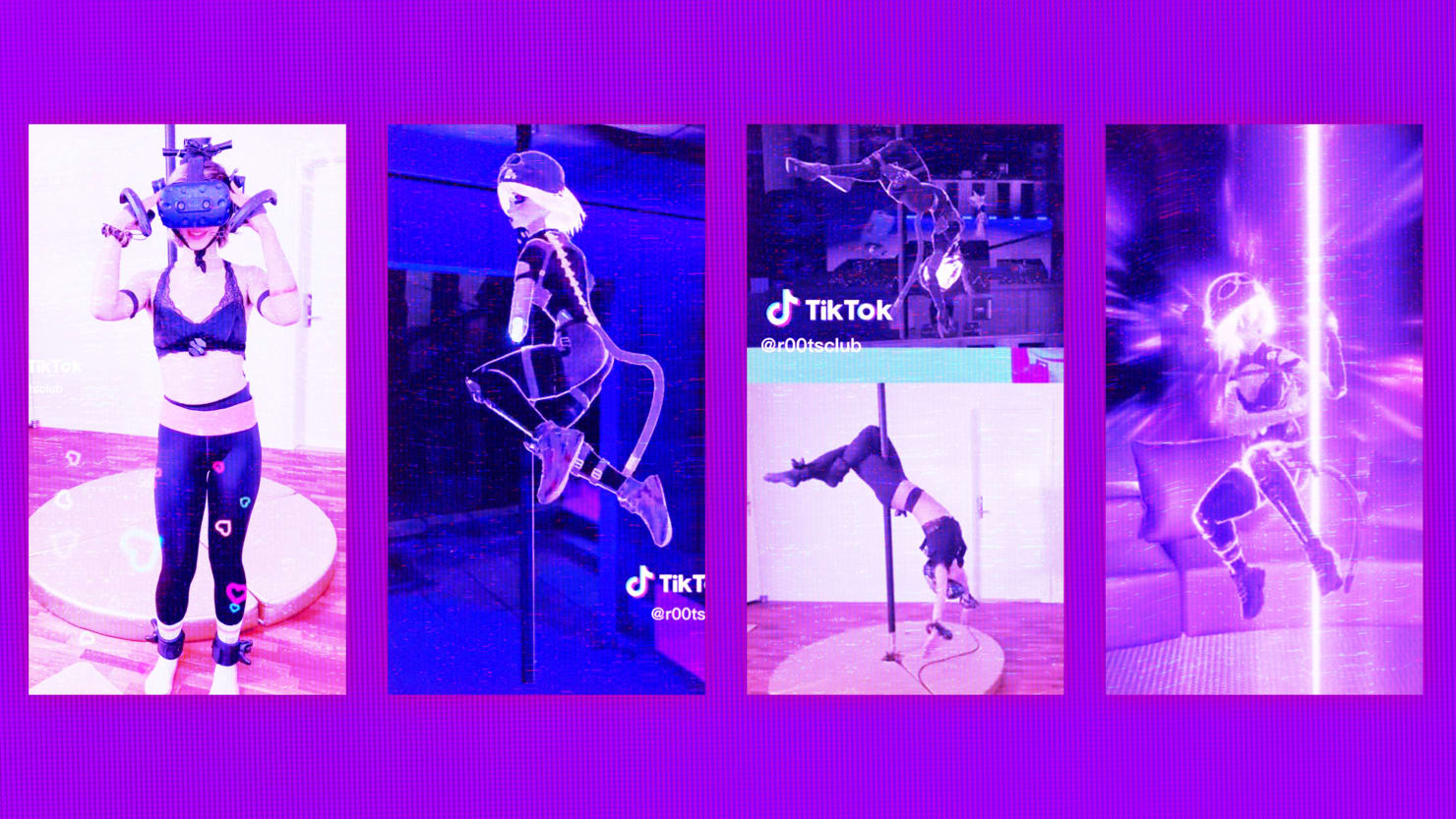Outside of my day job reporting on science and technology, I teach pole dance. While scrolling through social media in between classes, I was “blessed by the algorithm,” as my colleague would say, and came across a video of a pole dancer performing in a nightclub. Her shoulder-length hair seemed to glow as she spun counter-clockwise, clad in a long sleeve black bodysuit. Her skin appeared grayish, and her long tail bounced behind her.
Did I mention she was pole dancing in the metaverse?
This creator, a Copenhagen-based virtual reality artist who uses the handle R00t, told The Daily Beast that she started working in VR in 2013. If it weren’t for the ability to put on a headset and stream as her avatar dancing, R00t said she wouldn’t have taken up pole dancing in the first place.
“I was personally exposed to a lot of racism during my childhood, which didn’t make me feel very comfortable about my skin,” said R00t, who is half Iranian and grew up in Germany. She added that, for her, “it wouldn’t really be an option to go pole dance in a class” in the physical world, saying that she would feel self-conscious about her skin and body hair.
During the early days of lockdown, though, she bought a chrome pole for her home and joined VRPD, a virtual reality pole dancing community that practices together on VRChat, a virtual world platform. The group’s Discord server is now nearly 550 members strong—but that doesn’t mean that pole dancing in VR is common or easy. R00t will be the first to tell you that it’s not.
For one, there’s the sheer physical strength, flexibility, and fluidity required to make the activity look easy (and believe me, it is anything but). The technology setup arguably requires just as much skill and finesse. A standard VR system uses three-point tracking: a headset and two controllers. To capture all the moving parts of dance, though, R00t uses an 11-point tracking system, which she manages by strapping on trackers that are around $130 each to places like her waist, ankles, and shoulders.
The chrome pole she initially purchased would reflect the laser signals emitted by the trackers, causing her avatar to glitch. She tried taping over the base of the pole and covering it with a silicone wrap before relenting and purchasing a silicone one.
The headset and trackers, unsurprisingly, make certain pole moves nearly impossible. Inverting, or flipping upside-down, is an important way to transition into moves, and move up and down the pole. R00t tends to find workarounds for inversions, though. “It feels like the biggest disorientation because you’re already kind of balancing the virtual and the real world,” she said. Not only that, the weight of the headset tips her head back when inverting and spinning quickly, putting her off balance and adding a type of motion sickness specific to users of VR technology—cybersickness on top of dizziness.
Finally, there’s an extremely silly issue with pole dancing in VR environments: There’s no pole. Some special-built virtual clubs (like the ones where VRPD members practice) come with virtual poles that users can tether themselves to. More whimsically, though, R00t’s friend will sometimes “be” the pole by adopting an avatar of one and standing very still where she’s dancing.
“It’s cool that we can do a performance together like this in a way,” R00t said. “And she’s really proud of it, like, ‘Hey, that’s me! I’m the pole’” All these complications mean that R00t’s performances glitch regularly, even though she’s been dancing in the metaverse for months.
Pole dance is admittedly a fringe case, but some of the technologies’ shortcomings speak to larger issues with virtual reality. The majority of headsets are uncomfortable on people with smaller heads and don’t allow users with longer hair to wear buns and braided styles, and the motion trackers also come with their fair share of problems.
“Honestly, the trackers that are out there slip—they’re not really made for female shapes,” R00t said. She’s considered selling her fix, which involves attaching the devices to exercise bands and other straps.
If the makers of virtual reality hardware and software could fix some of the issues that arise with pole dancing, they would inadvertently be solving concerns that a larger user base has with virtual reality: cybersickness, which limits the amount of time that headsets can be worn; unrealistic movement tracking and avatar rendering, which impedes self-expression; and latency, or lag, which can create barriers to interpersonal interactions.
“It’s been nearly 10 years that I keep saying, ‘I’m sure in a few years it’ll be so much easier,’” she said. “It is much easier today, no question, but it’s still a bit of a setup.”
A quick note on terminology: “pole dancing” and “stripping” are often used interchangeably to describe the professions of people who work in clubs, but in reality there is a broad spectrum of each activity. The two may overlap—many common pole dance moves were invented by strippers and sex workers, for instance—but they exist on their own, too.
Because of the stigma around sex work and the tendency to reduce these communities to oversimplifications, reports of “metaverse stripping” have exclusively focused on creators whose avatars give virtual lap dances, rather than pole dancers.
R00t’s motivation for pole dancing isn’t about making money, though; rather, it’s a way for her to express herself, build strength, and find community. She started r00ts.club, a place for underrepresented groups—especially female and nonbinary individuals—to explore the metaverse together. Last year, it became one organization supported by a creator’s fund from Somnium Space, a blockchain-powered VR platform.
“I’m doing this because I would have wished this existed when I got into the industry,” she said.
Despite the many, many technical difficulties, R00t loves performing in the metaverse because of the control it offers her as a creator. Unlike in the physical world, she has a direct say in what she looks like, how she performs, and who she allows to watch her.
She played around with dancing in different bodies—at one point “an old white dude,” she said—but ultimately settled on an avatar that shared many of her qualities, like her hair and propensity for hat-wearing. “It looks a bit like a badass for sure,” R00t said.
R00t prefers to make her character larger than life and perform high up in spaces even as she spins near the ground on her pole at home. And in the metaverse, she can mute with impunity and filter out avatars who come too close, making them disappear from her view.
During her performances, R00t is in a sandbox for her creative expression. She feels free from others’ gaze and assessments—something she never thought possible.
“When you pole dance, especially in VR, you barely see anything because you’re spinning around so fast, and you’re so focused in that moment,” she said. “It stops being about anyone else but you and your dance, and you’re safe.”



